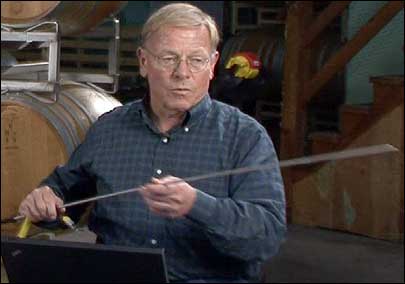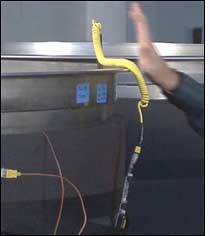When Cypress Semiconductor Corp.‘s CEO, T.J. Rodgers, wanted to put his company’s new product, known as the CyFi wireless sensor mesh system, to the test, he knew just where to go. Rodgers and his wife, Valeta, own a small wine company, Clos de la Tech, located in the Santa Cruz mountains. There, he cools, ferments and ages his pinot noir grape mix to make wine that he sells directly to customers, who order bottles online or by mail.
Pinot noir grapes require a long, cold soak prior to fermentation, and the temperature must remain within a specific range in order to maintain the quality of the grapes and their flavor. So with Cypress engineer Jim Davis at hand, Rodgers went about personally installing the system at his own winery, to track temperature changes in his product as it cools in the “cold soak” process prior to fermentation, as well as the equipment that keeps the wine cool.
It took Rodgers about two hours to install the system, which has been in place for the past five weeks. “I demanded of the engineers that they make it quick and reliable,” he says. “I asked for software that can be turned on in a few minutes, or that can change its configuration easily. The whole idea is that we don’t have time or money for conduit, wire and electricians.”
Cypress’ CY3271 PSoC FirstTouch starter kit, which Rodgers used to deploy his system, includes software, two transponders with built-in temperature sensors and an RFID interrogator (transceiver). The transponders and reader can be used to create a wireless mesh network of nodes that can track and transmit data regarding everything from temperature to security breeches, or changes in gauges at manufacturing sites, depending on the types of sensors to which the nodes are connected. When prompted by a signal from an interrogator, each transponder transmits 2.4 GHz signals containing its unique ID number and sensor data to other nodes, or directly to a reader that can plug into a laptop USB port. The transponders and interrogators employ a proprietary air-interface protocol to transmit their signals, with an average read range of 100 to 200 meters (328 to 656 feet).
For wineries, Rodgers says, the system can help reduce the man hours spent monitoring any temperature fluctuation in the wine mix temperatures. The process for making pinot noir wine can be time-consuming, since the grapes must cool to below 10 degrees Celsius (about 50 degrees Fahrenheit) for days, or even several weeks. That temperature must be monitored frequently—sometimes as often as every 15 minutes—to make sure the grape mix remains cool prior to fermentation. If the temperature fluctuates, the flavor of the mix can be compromised. For that reason, wine makers usually hire a large crew of employees who use a thermocouple to measure temperatures within the vats and record them on paper.
Rodgers, who has a small winemaking operation, had been utilizing a digital thermometer to check temperatures, whenever he had the opportunity to do so. He had no way of knowing, however, how temperatures may have fluctuated during his absence. The CyFi system, he hoped, would guarantee that temperatures were being monitored even when he could not be there.
Rodgers uploaded CyFi software onto his laptop and attached a battery-powered 2.4 GHz RFID transponder to one of his thermocouples. He then inserted the thermocouples, each attached to its own RFID node, in three vats of grape mix, as well as one in the insulating jacket outside the vat, to measure the temperature in the outer shell. Finally, he placed a thermocouple inside a refrigeration unit, located outside the building, that cools water in the outer shell for the vats. He also set the RFID interrogator to communicate with the nodes every five seconds.
With the reader plugged into the laptop USB port, Rodgers was able to receive data every five seconds from all of the sensors, with a visual alarm set to alert him if the temperature became too high or too low. The CyFi system software can also send an e-mail message or phone call via the laptop’s Wi-Fi connection to the Internet if the temperature passes beyond an accepted threshold. The installation took place in late October, Davis says, and has been working properly ever since.
Over the past five weeks, Rodgers has made several changes to the system. He disconnected the thermocouples he had been using during the cold soak of the grapes, and attached the transponders to humidity sensors, which he placed in the barrel room, where the mix is then stored to age and continue fermenting in barrels. There, he measures humidity rather than temperature, to ensure the room does not become too humid. In addition, he has loaded the system on his home computer, and has deployed transponders with humidity sensors in a barrel room at his house. “I needed this system to be easy,” he says, “When I have two tons of grapes sitting out there, I can’t be spending my time twiddling with radios.”
Although the system saves time for wine-making hobbyists, Davis says, “For a large wine company, this would be a tremendous advantage. This system is quite open-ended.” It can be customized to offer multiple features, such as monitoring other environmental factors, and its data can be shared remotely as long as the laptop has a Wi-Fi connection. What’s more, the system can be programmed to switch on a backup generator that powers refrigerating equipment if the temperature of a cooling pinot noir, for instance, suddenly rises.
In the future, Rodgers says, he expects the CyFi software to enable wineries to access data remotely, so a computer with Internet access can share information with another computer at a separate location. For Rodgers, that would mean he could track the temperatures of his vats offsite, from his home.
The kit, Davis says, is targeted for wine hobbyists or RF solutions providers that could package it for larger commercial clients. Cypress launched the wireless sensor network branch of its company in October. The firm also has a subsidiary, Cypress Envirosystems, that provides wireless gauge monitors, steam trap monitors and transducer readers. To view a video of Clos de la Tech’s RFID deployment, click here.



